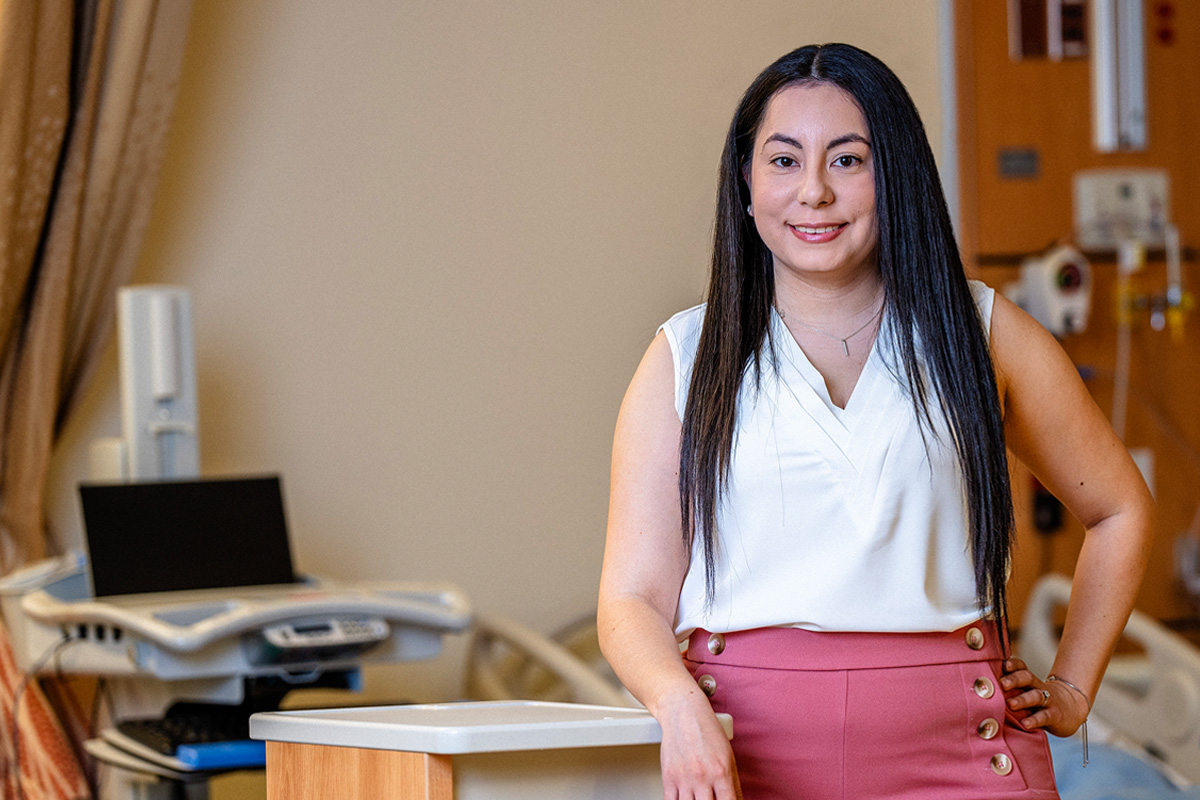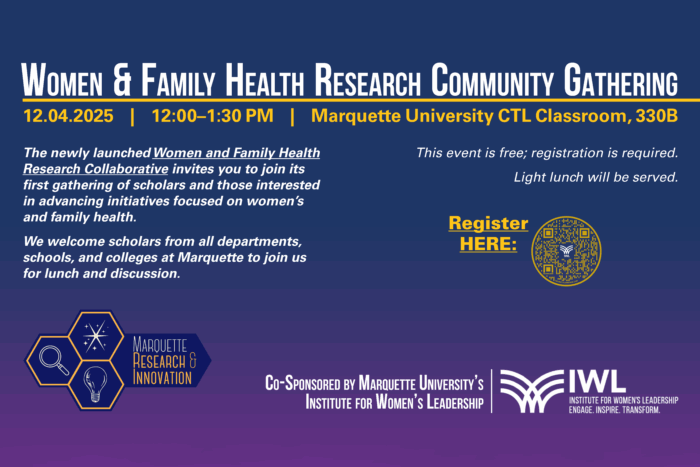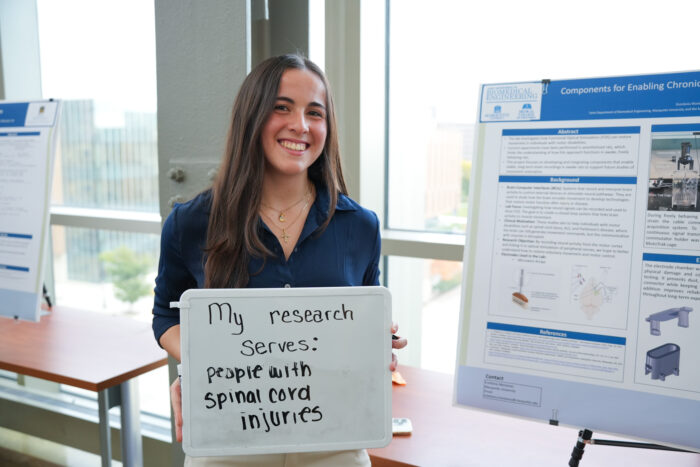The statistics relating to Hispanic women and cervical cancer could hardly be more clear or more alarming.
Hispanic women are 40 percent more likely to be diagnosed with cervical cancer — and 30 percent more likely to die from the disease — than non-Hispanic white women, according to the U.S. Department of Health and Human Services.
And although cervical cancer is the only gynecological cancer for which there is a screening test — allowing pre-cancerous conditions to be detected while still highly treatable — Hispanic women are less likely than their non-Hispanic Black and non-Hispanic white counterparts to be screened.
For Dr. Sylvia Peña, assistant professor of nursing, this is the kind of health disparity that calls out for a strong response. In fact, such disparities are a big reason why she pursued nursing in the first place, dating back to a situation she experienced as a teenager when volunteering at a reception desk of a Milwaukee hospital. Witnessing a Spanish-speaking mother struggling to secure help for her sick baby from English-speaking emergency room staff, Peña stepped in, using Spanish and English to help the woman communicate her baby’s needs. That experience left a deep impression, ultimately disrupting Peña’s plans to become a biomedical engineer.
“Being part of the Hispanic community, you see these inequities growing up that you don’t know are inequities,” she says. “Then you learn, that’s not supposed to happen.”
Now, to address cervical cancer disparities, Peña has responded by conducting an ambitious research study, with support from the Healthy Americas Foundation as part of a project providing grants to a cohort of 20 researchers across the country investigating the issue.
To conduct the study, Peña and her team recruited 150 Hispanic women from the Milwaukee area and surveyed them about their cervical cancer screening history and a range of life factors such as age, marital status, medical insurance coverage status, religiosity, acculturation and beliefs relating to cervical cancer screening. Peña learned that too many of the women — 26 percent of them — had not received a Pap smear, the screening test for cervical cancer.
The Pew Research Trust has reported that 83 percent of Hispanics identify with a religious affiliation, but using the Duke University Religion Index, which measures factors such as organized religious activity, non-organized religious activity and subjective religiosity, Peña did not find religiosity made women more or less likely to receive screening. The same held for the women’s level of acculturation, as measured by the Short Acculturation Scale for Hispanics, which measures such factors as residents’ generation, time of residence in the U.S., age at arrival where applicable and ethnic self-identification.
“As nurses we need to make sure we’re addressing the barriers that exist, and teaching our students how to address them. It’s not just saying the patients are non-compliant — assuming they don’t want to get cervical cancer screening or don’t want to eat nutritious meals. Instead, it’s thinking about all the barriers that actually exist to creating equity in the population.”
Dr. Sylvia Peña
Age and marital status, however, had a stronger bearing on screening history, with women 41 and older being 11 times more likely to obtain cervical cancer screening than women 40 and younger. Married women were 5 times more likely to have been screened than single women.
Women in the study with health insurance were more likely to be screened, but a significant number of these women — 24 percent — still went unscreened. “I expected women who had access to health insurance to get screening, because if you don’t have health insurance, then receiving most medical care is incredibly expensive. So, I expected a larger portion of women who had health insurance to have had cervical cancer screening, but about a fourth of them hadn’t received screening.”
That finding deserves further investigation, says Peña, including through the qualitative analysis of the survey results that her team is now conducting. Also of interest, she says, are responses to survey questions designed to measure respondents’ beliefs about the efficacy of the Pap test and barriers that stand in the way of receiving it.
Just two years into her faculty appointment, Peña is already targeting additional health disparities experienced by Hispanic people. Supported by a $50,000 award from AARP, the American Association of Retired Persons, she has developed a community health clinical residency for Marquette nursing students that specializes in providing bilingual dietary guidance to a largely Hispanic population of guests at the Milwaukee Christian Center.
Through the unique residency, more than a dozen Marquette nursing students over two semesters supported more than 450 community members. Guided by clinical instructors, the students educated MCC guests on beneficial nutritional choices based on individual needs, including allergies and underlying conditions such as diabetes and hypertension. A hallmark of the program was having the students build on therapeutic communication strategies, and cultural competence and humility skills, introduced to them in their first year of nursing study. As a result, students were able to avoid the generic recipe and menu advice that guests would likely encounter in other health care settings; instead students were able to provide options that felt relevant to guests’ culture and food traditions. And they communicated those options in the language guests preferred.
“Having students critically think and incorporate content learned in the freshman courses with the individuals they worked with at MCC helped avoid providing a one-size-fits-all health education model,” Peña says.
Peña also compiled data related to the bilingual clinical site, which will help generate a study about the effort. The findings will be presented at the annual conferences of the National Association of Hispanic Nurses and the International Association of Clinical Simulation and Learning this summer.
Although the specifics of the two projects are different, Peña has found synergies in tackling them at the same time. “It’s interesting to see the overlap, even though they are very different,” she says. “As nurses we need to make sure we’re addressing the barriers that exist, and teaching our students how to address them. It’s not just saying the patients are non-compliant — assuming they don’t want to get cervical cancer screening or don’t want to eat nutritious meals. Instead, it’s thinking about all the barriers that actually exist to creating equity in the population.”
“I have a passion for dismantling these inequities,” she says.



